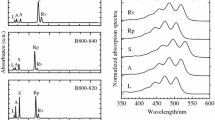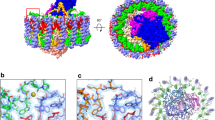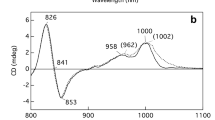Abstract
The absorption spectrum of the high-light peripheral light-harvesting (LH) complex from the photosynthetic purple bacterium Allochromatium vinosum features two strong absorptions around 800 and 850 nm. For the LH2 complexes from the species Rhodopseudomonas acidophila and Rhodospirillum molischianum, where high-resolution X-ray structures are available, similar bands have been observed and were assigned to two pigment pools of BChl a molecules that are arranged in two concentric rings (B800 and B850) with nine (acidophila) or eight (molischianum) repeat units, respectively. However, for the high-light peripheral LH complex from Alc. vinosum, the intruiging feature is that the B800 band is split into two components. We have studied this pigment–protein complex by ensemble CD spectroscopy and polarisation-resolved single-molecule spectroscopy. Assuming that the high-light peripheral LH complex in Alc. vinosum is constructed on the same modular principle as described for LH2 from Rps. acidophila and Rsp. molischianum, we used those repeat units as a starting point for simulating the spectra. We find the best agreement between simulation and experiment for a ring-like oligomer of 12 repeat units, where the mutual arrangement of the B800 and B850 rings resembles those from Rsp. molischianum. The splitting of the B800 band can be reproduced if both an excitonic coupling between dimers of B800 molecules and their interaction with the B850 manifold are taken into account. Such dimers predict an interesting apoprotein organisation as discussed below.








Similar content being viewed by others
References
Brotosudarmo THP, Kunz R, Böhm P et al (2009) Single-molecule spectroscopy reveals that individual low-light LH2 complexes from Rhodopseudomonas palustris 2.1.6. Have a heterogeneous polypeptide composition. Biophys J 97:1491–1500
Brunisholz RA, Zuber H (1992) Structure, function and organization of antenna polypeptides and antenna complexes from the 3 families of Rhodospirillaneae. J Photochem Photobiol B 15:113–140
Cantor CR, Schimmel PR (2001) Biophysical chemistry. Part II: techniques for the study of biological structure and function, 12th edn. Freeman and Company, New York
Cleary L, Chen H, Chuang C et al (2013) Optimal fold symmetry of LH2 rings on a photosynthetic membrane. Proc Natl Acad Sci USA 110:8537–8542
Cogdell RJ, Gall A, Köhler J (2006) The architecture and function of the light-harvesting apparatus of purple bacteria: from single molecules to in vivo membranes. Q Rev Biophys 39:227–324
Davydov AS (1967) On the operator of exciton–phonon interaction. Phys Status Solidi 20:143–151
de Caro C, Visschers RW, van Grondelle R et al (1994) Inter- and intraband energy transfer in LH2–antenna complexes of purple bacteria. A fluorescence line-narrowing and hole-burning study. J Phys Chem 98:10584–10590
Gläser J, Overmann J (1999) Selective enrichment and characterization of Roseospirillum parvum, gen. nov and sp nov., a new purple nonsulfur bacterium with unusual light absorption properties. Arch Microbiol 171:405–416
Hofmann C, Ketelaars M, Matsushita M et al (2003) Single-molecule study of the electronic couplings in a circular array of molecules: light-harvesting-2 complex from Rhodospirillum molischianum. Phys Rev Lett 90:013004
Hofmann C, Aartsma TJ, Michel H et al (2004) Spectral dynamics in the B800 band of LH2 from Rhodospirillum molischianum: a single-molecule study. N J Phys 6:1–15
Hu XC, Ritz T, Damjanovic A et al (2002) Photosynthetic apparatus of purple bacteria. Q Rev Biophys 35:1–62
Hunter CN, Daldal F, Thurnauer MC et al (eds) (2009) The purple phototrophic bacteria. Springer, Dordrecht
Imhof JF (1995) Taxonomy and physiology of phototrophic purple bacteria and green sulfur bacteria. In: Blankenship RE, Madigan MT, Bauer CE (eds) Anoxygenic photosynthetic bacteria. Kluwer Academic Publishers, Dordrecht
Kereïche S, Bourinet L, Keegstra W et al (2008) The peripheral light-harvesting complexes from purple sulfur bacteria have different ‘ring’ sizes. FEBS Lett 582:3650–3656
Knox RS (1963) Theory of excitons. Academic Press, New York
Koolhaas MH, van der Zwan G, van Mourik F et al (1997) Spectroscopy and structure of bacteriochlorophyll dimers. 1. Structural consequences of nonconservative circular dichroism spectra. Biophys J 72:1828–1841
Köpke J, Hu X, Münke C et al (1996) The crystal structure of the light-harvesting complex II (B800–850) from Rhodospirillum molischianum. Structure 4:581–597
Lang E, Baier J, Köhler J (2006) Epifluorescence, confocal and total internal reflection microscopy for single-molecule experiments: a quantitative comparison. J Microsc (Oxf, UK) 222:118–123
McDermott G, Prince SM, Freer AA et al (1995) Crystal structure of an integral membrane light-harvesting complex from photosynthetic bacteria. Nature 374:517–521
McLuskey K, Prince SM, Cogdell RJ et al (2001) The crystallographic structure of the B800–820 LH3 light-harvesting complex from the purple bacteria Rhodopseudomonas acidophila strain 7050. Biochemistry 40:8783–8789
Niedzwiedzki DM, Fuciman M, Kobayashi M et al (2011) Ultrafast time-resolved spectroscopy of the light-harvesting complex 2 (LH2) from the photosynthetic bacterium Thermochromatium tepidum. Photosynth Res 110:49–60
Niedzwiedzki DM, Bina D, Picken N et al (2012) Spectroscopic studies of two spectral variants of light-harvesting complex 2 (LH2) from the photosynthetic purple sulfur bacterium Allochromatium vinosum. Biochim Biophys Acta Bioenerg 1817:1576–1587
Papiz MZ, Prince SM, Howard T et al (2003) The structure and thermal motion of the B800–850 LH2 complex from Rps. acidophila at 2.0 (A)over-circle resolution and 100 K: new structural features and functionally relevant motions. J Mol Biol 326:1523–1538
Pfennig N (1967) Photosynthetic bacteria. Annu Rev Microbiol 21:285–324
Sauer K, Cogdell RJ, Prince SM et al (1996) Structure-based calculations of the optical spectra of the LH2 bacteriochlorophyll–protein complex from Rhodopseudomonas acidophila. Photochem Photobiol 64:564–576
van Oijen AM, Ketelaars M, Köhler J et al (1999) Unraveling the electronic structure of individual photosynthetic pigment–protein complexes. Science 285:400–402
van Oijen AM, Ketelaars M, Köhler J et al (2000) Spectroscopy of individual light-harvesting 2 complexes of Rhodopseudomonas acidophila: diagonal disorder, intercomplex heterogeneity, spectral diffusion, and energy transfer in the B800 band. Biophys J 78:1570–1577
Walz T, Jamieson SJ, Bowers CM et al (1998) Projection structures of three photosynthetic complexes from Rhodobacter sphaeroides: LH2 at 6 Angstrom LH1 and Rc-LH1 at 25 Angstrom. J Mol Biol 282:833–845
Wu HM, Reddy NR, Cogdell RJ et al (1996) A comparison of the LH2 antenna complex of three purple bacteria by hole burning and absorption spectroscopies. Mol Cryst Liq Cryst Sci Technol A 291:163–173
Yurkov VV, Beatty JT (1998) Aerobic anoxygenic phototrophic bacteria. Microbiol Mol Biol Rev 62:695–724
Acknowledgments
A. L. and J. K. thankfully acknowledge financial support by the Deutsche Forschungsgemeinschaft (GRK1640) and the State of Bavaria within the initiative “Solar Technologies go Hybrid”. A.-M. C. is supported as a part of the Photosynthetic Antenna Research Centre (PARC), an Energy Frontier Research Centre funded by the DOE, Office of Science, Office of Basic Energy Sciences under Award Number DE-SC 0001035. She carried out the Car: Bchl ratio study and the CD spectroscopy (with K.H. and S.K.). K. H. is supported by an EPSRC studentship. R. J. C. thanks both DOE and BBSRC for support.
Author information
Authors and Affiliations
Corresponding author
Electronic supplementary material
Below is the link to the electronic supplementary material.
Rights and permissions
About this article
Cite this article
Löhner, A., Carey, AM., Hacking, K. et al. The origin of the split B800 absorption peak in the LH2 complexes from Allochromatium vinosum . Photosynth Res 123, 23–31 (2015). https://doi.org/10.1007/s11120-014-0036-2
Received:
Accepted:
Published:
Issue Date:
DOI: https://doi.org/10.1007/s11120-014-0036-2




